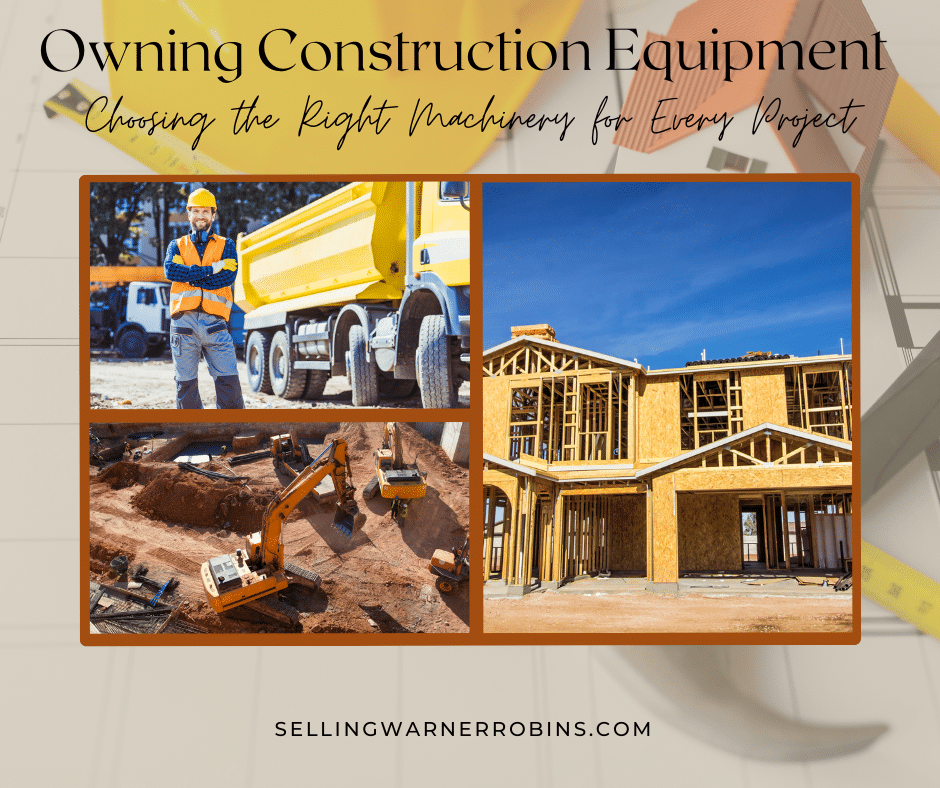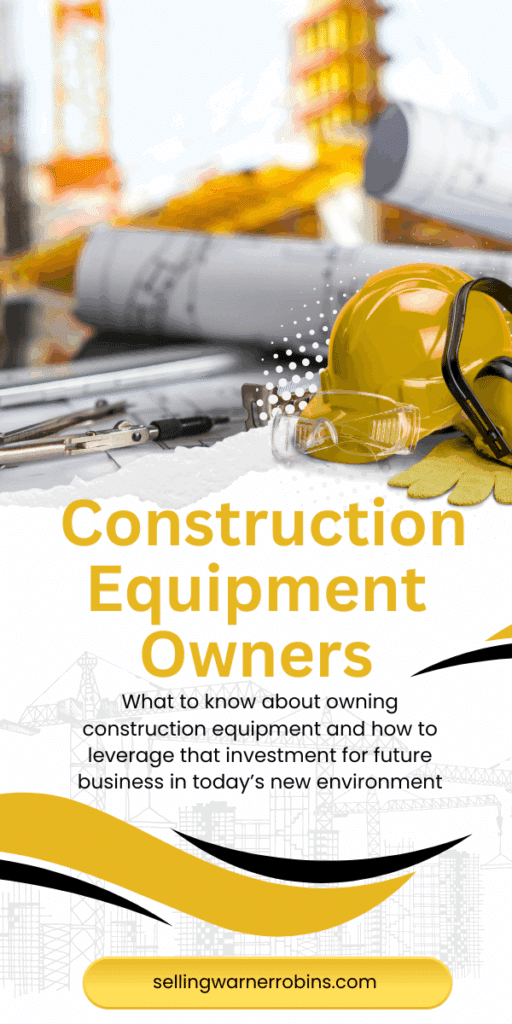What to Know About Owning Construction Equipment
How do successful construction companies manage their equipment investments so effectively? Owning construction equipment is a critical choice that can significantly impact your business’s success and long-term growth potential.
Whether you’re considering purchasing your first piece of heavy machinery or expanding your existing fleet, understanding the complexities of equipment ownership can help you make informed decisions that align with your business goals and operational needs.
Between choosing the right machinery, maintaining it properly, and tracking its performance, a strategic approach to equipment ownership can transform your construction business from surviving to thriving, winning more home construction projects as a result. Check out these tips on owning construction equipment and how you can best leverage that option if necessary.

Choosing the Right Machinery for Every Project
Selecting suitable construction equipment is crucial for project success and overall efficiency. Wise equipment choices affect your bottom line, productivity, and project timelines. The right machinery can transform your worksite operations while keeping costs manageable.
Each piece of equipment must match your specific project needs and operational goals. Your choice should reflect careful consideration of the machine’s capacity, accessibility, and practical application on the site.
Construction teams that invest in heavy-duty attachments for skid steers often see improved resource optimization across different tasks. To further guide your selection process, here are critical factors to consider when choosing construction equipment:
- Match equipment size to project scope and site constraints
- Consider fuel efficiency and operating costs
- Factor in equipment versatility and adaptability
- Evaluate lifting capacity and reach requirements
- Account for terrain conditions and accessibility
Remember that each machine serves unique purposes on your construction site. You’ll create a more efficient workflow and reduce unnecessary expenses by picking equipment that aligns with your project demands. The key lies in balancing functionality, cost, and versatility.
|
Prioritize equipment needs: Meet with your project leads to review upcoming jobsite demands and determine what machinery functionality will be needed most often. This ensures you invest in equipment that aligns with real-world tasks rather than assumptions. |
Financial Considerations for Equipment Ownership
Buying construction equipment requires careful financial planning beyond the initial price tag. Total ownership costs include regular expenses like insurance premiums, property taxes, and loan interest payments.
These ongoing costs can add up quickly and affect your bottom line more than expected. Beyond the initial purchase price, several other financial factors contribute to the total cost of equipment ownership:
- Monthly insurance payments to protect against theft, damage, and liability
- Annual property tax assessments based on equipment value
- Regular interest payments if financing through loans
- Storage facility costs during off-season periods
- Administrative expenses for paperwork and compliance
Smart business owners look at their cash flow patterns and project schedules before deciding whether to buy or rent.
If you’ve got steady, long-term projects lined up, purchasing might make more financial sense. But if your work is seasonal or project-based, renting could be a more intelligent choice.
The key is matching your equipment strategy with your business’s unique needs and financial capabilities.
Looking at similar equipment and market prices helps you gauge whether buying makes sense for your situation. You’ll want to calculate potential returns from ownership against the flexibility that comes with renting.
Remember, tying up too much capital in equipment could limit your ability to take on new home construction opportunities or handle unexpected expenses.
Evaluating Buy, Lease, or Rent Scenarios
Making wise choices about construction equipment acquisition can make or break your business’s success. Each option—buying, leasing, or renting—has advantages that fit different business situations.
Your project timeline and usage patterns are key in determining the most cost-effective choice. You must adjust accordingly:
- Purchase: Best for consistent, long-term use with predictable workloads
- Lease: Ideal for medium-term projects with fixed monthly payments
- Rent: Perfect for short-term needs or specialized equipment testing
- Hybrid approach: Mix of owned and rented equipment for flexibility
- Tax considerations: Different write-off options for each acquisition method
Each acquisition method affects your cash flow differently. Buying ties up capital but builds equity, while leasing preserves cash with predictable payments.
Renting offers maximum flexibility, and many contractors find that skid steer attachments can expand their equipment’s capabilities without additional machinery purchases.
Your business growth strategy should guide your equipment decisions. Ownership might make sense if you’re experiencing steady growth with consistent demand.
However, if your workload fluctuates or you’re testing new service offerings, starting with rentals could be smarter. The key is matching your equipment strategy to your business goals while maintaining financial flexibility.
|
Maximize equipment utilization: When evaluating your equipment options, factor in how seasonal demand or project diversity could impact utilization rates—low usage on owned machines can quietly drain profitability over time. |
Regular Maintenance and Repair Practices
Good maintenance habits are vital in keeping your construction equipment running smoothly and reliably. By performing preventive maintenance, you’ll extend the life of your machines while avoiding costly breakdowns.
Following the manufacturer’s suggested service intervals helps catch minor issues before they become significant problems.
Keeping detailed maintenance records isn’t just about tracking what’s been done; it’s about building a complete picture of your equipment’s health.
These logs help identify patterns and predict when components might need attention, letting you plan repairs during off-hours instead of dealing with sudden failures on the job. To maintain a thorough maintenance program and ensure longevity, here are the key practices to implement:
- Create a calendar-based maintenance schedule for each piece of equipment
- Track oil changes, filter replacements, and other routine services
- Document any repairs or part replacements
- Monitor fluid levels and belt conditions regularly
- Keep inspection checklists for daily equipment checks
Taking care of your heavy machinery through consistent upkeep saves money in the long run. Regular oil analysis can spot engine wear before it causes damage, while checking tire pressure and track tension helps prevent unnecessary strain on moving parts.
Innovative maintenance practices and proper operator training create a solid foundation for equipment longevity and reliability.
Tracking Productivity and Utilization
Monitoring construction equipment usage helps you make better decisions about your fleet management. By keeping tabs on your machinery’s performance and usage patterns, you’ll spot which pieces are pulling their weight and which might be sitting idle too often. 
This data-driven approach to equipment management lets you fine-tune your operations and cut unnecessary costs.
Key Construction Equipment Metrics to Track
Here’s what you should track to maximize your equipment’s value:
- Daily operating hours and idle time ratios
- Fuel consumption rates and efficiency metrics
- Project completion times with specific machines
- Maintenance schedules and downtime frequency
- Equipment location and movement patterns
By analyzing these metrics regularly, you can make informed choices about keeping, selling, or adding equipment to your fleet. This balanced approach ensures you get the most value from your machinery investments while keeping your business competitive and efficient.
Risks and Rewards of Pre-Owned Machinery
Pre-owned construction equipment can be a smart financial move for smaller contractors looking to grow their business. While cost savings can be substantial, it’s essential to consider these purchases carefully.
Making the correct choice means balancing the potential benefits against possible mechanical issues that could arise down the line. To minimize risks and maximize the value of a pre-owned purchase, look for the following:
- Complete service history documentation: This provides a clear record of past maintenance and repairs, indicating how well the machine has been cared for.
- Comprehensive mechanical inspection reports: Detailed reports from qualified mechanics can highlight any existing or potential mechanical issues.
- Verification of hour meter readings: Confirming the accuracy of hour meters helps assess the true extent of the machine’s usage.
- Assessment of wear patterns on critical components: Examining parts like tracks, tires, and hydraulic cylinders can reveal how hard the machine has been worked.
- Review of previous maintenance schedules: Understanding past maintenance frequency and adherence to manufacturer guidelines offers insights into the machine’s longevity.
- Authentication of ownership records: Verifying ownership ensures a legitimate transaction and prevents future legal complications.
A thorough inspection by qualified mechanics can reveal potential problems before they become expensive repairs. The right pre-owned machine can deliver excellent value if you take time to check fluid levels, test operational systems, and examine structural integrity. Pay special attention to wear points like pins, bushings, and hydraulic components.
Don’t rush into buying used equipment without proper research. Working with reputable dealers and requesting detailed maintenance logs will help protect your investment.
Consider bringing along an experienced operator during inspections. They often spot issues that might not be obvious to others. Their practical insights and professional evaluations are the foundation for sound purchasing decisions.
Operational Skills and Safety Requirements
Well-trained operators are the backbone of successful construction equipment operations. Their expertise in handling machinery directly affects project outcomes and team safety.
Beyond basic operation, skilled workers need a firm grasp of safety protocols and emergency procedures to handle various situations on the job site.
Construction equipment operation demands a mix of technical knowledge and practical skills. Operators must master specific techniques for different machines while staying alert to their surroundings.
Understanding load limits, equipment capabilities, and proper startup procedures helps prevent accidents and extends machine life. Here’s what a comprehensive operator training program should cover:
- Basic equipment controls and advanced operating techniques
- Daily inspection and maintenance checks
- Emergency response procedures and safety protocols
- Communication signals and site coordination methods
- Proper shutdown and storage procedures
Regular skill assessments and refresher courses keep operators up-to-date with the latest safety standards and equipment features. This ongoing education helps reduce workplace incidents and equipment damage.
Many construction companies find that investing in operator training pays off through improved productivity, reduced maintenance costs, and fewer accidents on the job site.
Long-Term Planning for Asset Management
A well-structured asset management plan helps construction businesses maintain a competitive edge while keeping their equipment fleet up-to-date.
Creating clear replacement timelines and regular evaluation schedules will keep your machinery running at peak performance and help you avoid potential issues.
Thoughtful planning for your construction assets involves setting specific equipment upgrades and replacements goals. This forward-thinking approach helps you avoid rushed decisions and unexpected expenses that could strain your budget.
To effectively manage your assets and ensure a future-ready fleet, consider these essential components of a robust asset management plan:
- Track equipment age and performance to identify optimal replacement timing
- Set up dedicated maintenance funds for each piece of machinery
- Create detailed records of repairs and service costs
- Monitor industry standards and land use regulations to ensure compliance
- Develop relationships with reliable equipment dealers and service providers
Your asset management strategy should include regular fleet assessments to identify which machines are performing well and which might need replacement soon. This helps you budget effectively and maintain steady cash flow for your business.
Smart Equipment Ownership Strategies
Owning construction equipment is a significant investment that requires careful planning, consistent maintenance, and strategic decision-making to maximize returns while minimizing risks.
Throughout this guide, we’ve explored how choosing the right equipment and maintaining it properly can significantly impact your business’s success and bottom line.
Whether you’re just starting or looking to expand your fleet, remember that smart equipment ownership is about finding the perfect balance between your operational needs and financial capabilities, while never compromising safety and maintenance standards.
The future of your construction business depends on the equipment decisions you make today.
If you found this article on owning construction equipment helpful, please the article so more consumers can also benefit from the information provided.
What You Need To Know About Owning Construction Equipment
About Anita Clark Realtor
Anita Clark has written 687 posts on this blog.
by Anita Clark Anita is a residential Real Estate Agent in Warner Robins Georgia, with Coldwell Banker Access Realty (478) 953-8595, aiding buyers and sellers with all their real estate questions on her Warner Robins blog.



